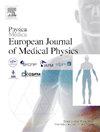基于肿瘤侵袭模型的胶质母细胞瘤治疗结果预测的放射组学和深度学习模型。
IF 3.3
3区 医学
Q1 RADIOLOGY, NUCLEAR MEDICINE & MEDICAL IMAGING
Physica Medica-European Journal of Medical Physics
Pub Date : 2025-01-01
DOI:10.1016/j.ejmp.2024.104881
引用次数: 0
摘要
目的:通过评估多形性胶质母细胞瘤(GBM)临床靶体积(CTV)对治疗结果的影响,特别是总生存期(OS)时间,研究使用生物物理指导方法描绘临床靶体积(CTV)的可行性。方法:采用建立的反应-扩散模型,模拟GBM患者T1-MRI影像中癌区时空演变。量化该模型参数对模拟肿瘤边界的影响,并利用最优值估计浸润细胞的分布(ctv模型)。放射组学和深度学习模型通过分析GTV、临床CTV和CTV模型来预测OS时间。结果:本研究共涉及126名被试进行模型开发,62名独立被试进行测试。对该方法的评估表明,与临床定义的CTV相比,该方法对OS时间的预测能力相当。具体而言,对于短时间与长时间的二元生存预测,所提出的ctv模型在AUROC方面的预后能力有所提高,无论是验证集(从0.75提高到0.77)还是测试集(从0.71提高到0.73)。对三类预测和生存回归模型的定量比较显示出类似的可比性趋势。结论:这些发现突出了生物物理模型在估计浸润细胞的扩散并将其纳入CTV描绘方面的潜力。需要进一步的临床研究来验证临床疗效。本文章由计算机程序翻译,如有差异,请以英文原文为准。
Radiomics and deep learning models for glioblastoma treatment outcome prediction based on tumor invasion modeling
Purpose
We investigate the feasibility of using a biophysically guided approach for delineating the Clinical Target Volume (CTV) in Glioblastoma Multiforme (GBM) by evaluating its impact on the treatment outcomes, specifically Overall Survival (OS) time.
Methods
An established reaction–diffusion model was employed to simulate the spatiotemporal evolution of cancerous regions in T1-MRI images of GBM patients. The effects of the parameters of this model on the simulated tumor borders were quantified and the optimal values were used to estimate the distribution of infiltrative cells (CTVmodel). Radiomics and deep learning models were examined to predict the OS time by analyzing the GTV, clinical CTV, and CTVmodel.
Results
The study involves 126 subjects for model development and 62 independent subjects for testing. Evaluation of the proposed approach demonstrates comparable predictive power for OS time that is achieved with the clinically defined CTV. Specifically, for the binary survival prediction, short vs. long time, the proposed CTVmodel resulted in improvements of prognostic power, in terms of AUROC, both for the validation (0.77 from 0.75) and the testing (0.73 from 0.71) set. Quantitative comparisons for three-class prediction and survival regression models exhibited a similar trend of comparable performance.
Conclusion
The findings highlight the potential of biophysical modeling for estimating and incorporating the spread of infiltrating cells into CTV delineation. Further clinical investigations are required to validate the clinical efficacy.
求助全文
通过发布文献求助,成功后即可免费获取论文全文。
去求助
来源期刊
CiteScore
6.80
自引率
14.70%
发文量
493
审稿时长
78 days
期刊介绍:
Physica Medica, European Journal of Medical Physics, publishing with Elsevier from 2007, provides an international forum for research and reviews on the following main topics:
Medical Imaging
Radiation Therapy
Radiation Protection
Measuring Systems and Signal Processing
Education and training in Medical Physics
Professional issues in Medical Physics.

 求助内容:
求助内容: 应助结果提醒方式:
应助结果提醒方式:


